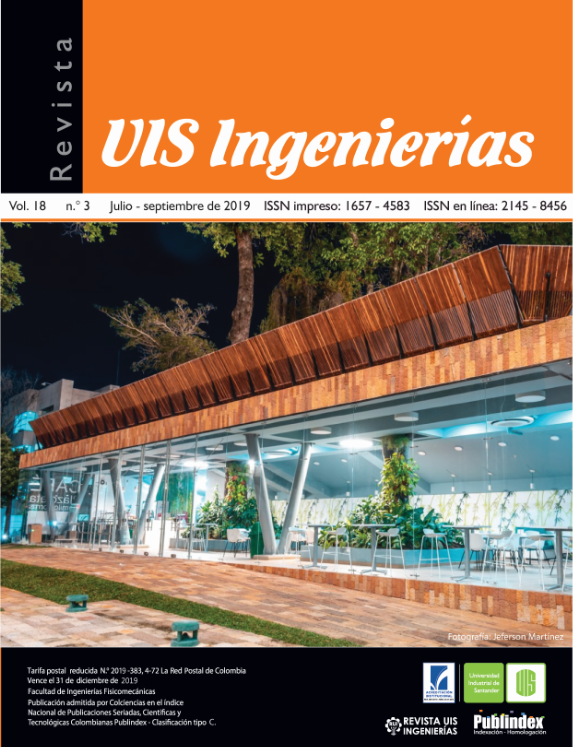Publicado 2019-03-29
Palabras clave
- planificación de rutas,
- entornos urbanos,
- deep learning,
- posicionamiento satelital
Cómo citar
Resumen
Un posicionamiento mediante un servicio GNSS (sistema global de navegación por satélite) solo es posible con la recepción simultánea de la señal de al menos cuatro satélites. La probabilidad de pérdida de visibilidad de los satélites GNSS en entornos urbanos es especialmente crítica por los elementos arquitecturales propios de una ciudad, y esto puede imposibilitar la localización de un receptor. Esto será crucial para ciertas aplicaciones, por ejemplo, un vehículo transportador de valores que requiera un monitoreo continuo de su posición. Este trabajo describe un método de planificación de rutas urbanas en función de las necesidades de posicionamiento, integrando el cálculo de la posición de los satélites a través de la mecánica orbital, con imágenes de Google Street View y segmentación semántica con técnicas de Deep Learning. De esta manera, predecir la relación de visibilidad entre un observador y los satélites de un servicio GNSS.
Descargas
Referencias
[2] A. Amini, R. M. Vaghefi, J. M. de la Garza, and R. M. Buehrer, “Improving GPS-based vehicle positioning for Intelligent Transportation Systems,” in 2014 IEEE Intelligent Vehicles Symposium Proceedings, 2014, pp. 1023–1029. doi: 10.1109/IVS.2014.6856592
[3] D. A. Álvarez García, “Sistema GNSS (Global Navigation Satellite System),” Universidad Autónoma de Madrid, 2008.
[4] R. M. White and R. B. Langley, “Precise Point Positioning with Galileo Observables,” in Proceedings of 5th Int. Colloquium on Scientific and Fundamental Aspects of the Galileo Programme, 2015, pp. 27–29.
[5] F. R. Hoots and R. L. Roehrich, “Spacetrack report no. 3, models for propagation of norad element sets,” Spacetrack Rep., vol. 3, no. 3, pp. 1–91, 1980.
[6] J. Bradbury, M. Ziebart, P. A. Cross, P. Boulton, and A. Read, “Code Multipath Modelling in the Urban Environment Using Large Virtual Reality City Models: Determining the Local Environment,” J. Navig., vol. 60, no. 1, pp. 95–105, 2007. doi: 10.1017/S0373463307004079
[7] U. Ujang, F. Anton, and A. A. Rahman, “Unified Data Model of Urban Air Pollution Dispersion and 3D Spatial City Model: Groundwork Assessment towards Sustainable Urban Development for Malaysia,” J. Environ. Prot. (Irvine,. Calif)., vol. 4, no. 7, pp. 701–712, Jul. 2013. doi: 10.4236/jep.2013.47081
[8] F. Biljecki, H. Ledoux, X. Du, J. Stoter, K. H. Soon, and V. H. S. Khoo, “The Most Common Geometric And Semantic Errors In Citygml Datasets,” in 11th 3D Geoinfo Conference, 2016, pp. 13–22. doi: 10.5194/isprs-annals-IV-2-W1-13-2016
[9] R. Goel et al., “Estimating city-level travel patterns using street imagery: A case study of using Google Street View in Britain,” PLoS One, vol. 13, no. 5, May 2018. doi: 10.1371/journal.pone.0196521
[10] J. J. Burke, Stereographic Projection of Radar Data in a Netted Radar System. 1973.
[11] K. W. Oh, J. Haberl, and L. Degelman, “Enhanced Software for Displaying Orthographic, Stereographic, Gnomic and Cylindrical Projections of the Sunpath Diagram and Shading Mask Protractor,” in H&H - Symposium on Improving Building Systems in Hot and Humid Climates, 2000.
[12] L. C. L. Souza, D. S. Rodrigues, and J. F. G. Mendes, “A 3D-gis extensionf for sky view factors assessment in urban environment,” in 8th International Conference on Computers in Urban Planning and Urban Management, 2003.
[13] L.-C. Chen, G. Papandreou, K. Murphy, and A. L. Yuille, “Semantic Image Segmentation With Deep Con-Volutional Nets And Fully Connected Crfs,” in ICLR 2015.
[14] V. Badrinarayanan, A. Kendall, and R. Cipolla, “SegNet: A Deep Convolutional Encoder-Decoder Architecture for Image Segmentation,” IEEE Trans. Pattern Anal. Mach. Intell., vol. 39, no. 12, pp. 2481–2495, 2017. doi: 10.1109/TPAMI.2016.2644615
[15] A. Kendall, V. Badrinarayanan, and R. Cipolla, Bayesian SegNet: Model Uncertainty in Deep Convolutional Encoder-Decoder Architectures for Scene Understanding. 2015.
[16] M. Greene and R. Zee, “Increasing the Accuracy of Orbital Position Information from NORAD SGP4 Using Intermittent GPS Readings,” in 23rd AIAA/USU Conference on Small Satellites, 2009.
[17] B.-S. Lee, “NORAD TLE Conversion from Osculating Orbital Element,” J. Astron. Sp. Sci., vol. 19, pp. 395–402, Dec. 2002.
[18] W. Dong and Z. Chang-yin, “An Accuracy Analysis of the SGP4/SDP4 Model,” Chinese Astron. Astrophys., vol. 34, no. 1, pp. 69–76, 2010. doi: 10.1016/j.chinastron.2009.12.009
[19] A. Abdelaziz, B. A, I. Hassan, and M. A. Awad, “Perturbation Effect On Ground Tracks Of Satellites Orbits.”. [Online]. Available: https://www.researchgate.net/publication/ 287640820_PERTURBATION_EFFECT_ON_GROUND_TRACKS_OF_SATELLITES_ORBITS. [Accessed: 31-Jan-2018].
[20] C. Parente and C. Meneghini, “Advantages of Multi GNSS Constellation: GDOP Analysis for GPS, GLONASS and Galileo Combinations,” Int. J. Eng. Technol. Innov., vol. 7, no. 1, pp. 1–10, Jan. 2017.
[21] D. Pandey, R. Dwivedi, O. Dikshit, and A. Singh, “GPS and glonass combined static precise point positioning (PPP),” in ISPRS - International Archives of the Photogrammetry, Remote Sensing and Spatial Information Sciences, 2016, vol. XLI-B1, pp. 483–488. doi: 10.5194/isprsarchives-XLI-B1-483-2016

